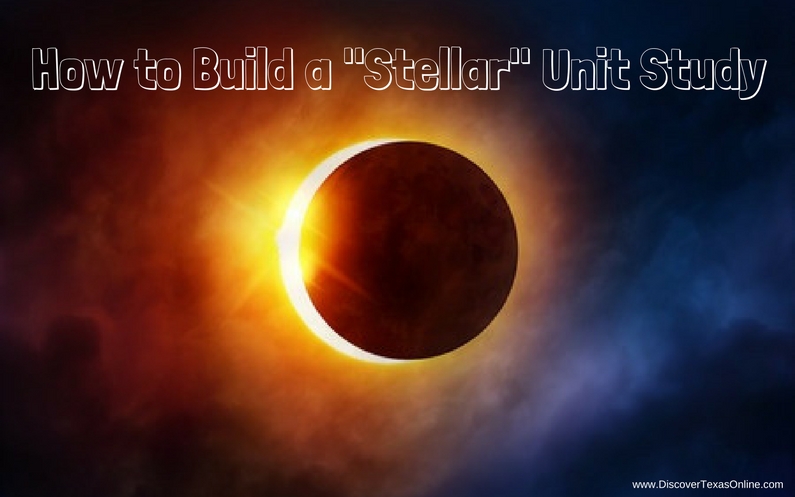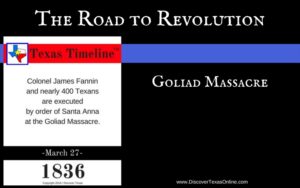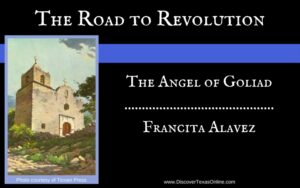
I’ve gotten a lot of questions and comments about Discover Texas over the years–not questions about Texas history, but about the teaching approach we used to make learning meaningful, memorable, and fun. We specialize in unit studies like the ones in the Doing More section because unit Studies are an EXCELLENT hands-on way to keep students engaged and excited about what they’re learning.
I’d like to show you how you can put together a truly “stellar” unit study of your own. Let’s use today’s solar eclipse as an example.
Start with a basic topic or event, i.e. Most of the United States will experience a total or near-total solar eclipse today, and everybody’s talking about it.
Then start brainstorming ways to learn about your topic from the vantage point of every subject you teach. Be sure to include visual, auditory, and tactile learning. Is you get stuck, just start asking questions that make you curious…then figure out how to learn them. You’ll be modeling for your children how to be inquisitive, active, self-initiating scholars! 🙂
Here are some ideas I came up with…but you’ll likely have others to add!
Science/current events:
- What is a solar eclipse, and how does is it different from a lunar eclipse? How could we find out?
Library, internet research. No special purchase required.
- Watch the solar eclipse.
View the solar eclipse safely by using a thumbtack to poke a hole in an index card. Take the card outside and align it so that direct sunlight can pass through the pinhole to cast a shadow on a sheet of white paper. You’ll be able to see the occlusion in the shadow.
- Why does the viewing path slant across the country instead of lining up neatly?
Our planet spins around an axis that is about 23 degrees off vertical. This affects seasonal differences as well as the path of an eclipse.
- Why do some regions experience a full eclipse, while others see only a partial eclipse, and other parts of the world see none of it?
The answer is related to the earth’s tilt and the path of the sun and moon. You can easily demonstrate by holding a paper plate up in front of a light source and letting your students view it from various positions. When they stand directly in line with the plate, it will block the light source entirely; but if they move to either side, they will be able to see more of the light source. They can also stand in one place and move the plate across their field of vision to simulate the moon moving in a path that eventually blocks the sun and then moving on in its orbit.
- Did you know our sun is a star just like the other stars we see at night?
It has a name: Sol. That’s why we say our planet is in the SOLar system and why this is a SOLar eclipse. What if we lived on a planet in orbit around some other star like Regulus or Vega? What would we call our system then? Could an eclipse still happen? Why wouldn’t we call it a SOLar eclipse? What might we call it instead? Why don’t we see the other stars during the day? Why do we not see our star, SOL at night?
- How often to solar eclipses occur?
Find out when the last one was and when the next one will be. Find out how astronomers find out. See if there’s an observatory, planetarium, or even a stargazers’ club in your area. Take a field trip, if possible.
- What are “Baily’s beads”?
When you’re putting together a unit study, listen for ideas in news posts or look for ideas on line. For example, a newscaster talking about today’s eclipse made reference to Baily’s beads, and I didn’t know what that was…so I looked it up. Took about 5 minutes. After an eclipse on May 15, 1836, English astronomer Francis Baily discovered and described a phenomenon that occurs seconds before and after totality in a solar eclipse. Help your students learn to do an online search to find images of Baily’s beads.
Math:
- How much is a 23 degree tilt?
Learn to use a protractor to find degrees. Draw a 23 degree angle, then draw Earth at a 23 degree angle. Find out about the angles of axis of the other planets in our solar system. Draw those, too, if you like. Let children walk around the house and yard finding other angles to measure.
- Talk about how a full circle is 360 degrees, and all other angles are measured in parts of a circle.
How do we write that mathematically (with little raised circle after the numerals)?
- Why did the light coming through the pinhole show the occlusion instead of a white circle?
You’ll need to start by looking at how our eyes or cameras focus light through a lens. Then draw an illustration of the light coming through the pinhole that shows how to focus the photo image on the paper. If you’re ambitions, you can try making a “shoebox camera” to experiment and learn how to predict angles and focus.
History:
- How rare is a total eclipse?
Make a timeline and plot the dates of total solar eclipses through history.
- What did people in history believe about eclipses?
For example, the Bible (in Matthew 27:45, Mark 15:33, and Luke 23:44) describes something like an eclipse that occurred from nine until noon on the day that Jesus was crucified. You may want to look up these passages. Could this have been a solar eclipse? Why, or why not?
I was sure there must be other examples. Another 5 minutes online produced several that would be fun to follow up on!
In 585 BC, according to the Greek historian Herodotus, a solar eclipse stopped a war between the Lydians and the Medes when each side interpreted the dark skies as a warning that they must make peace.
A partial eclipse was visible in Medina, Saudi Arabia in January 632 at the time of the death of Mohammad’s son, Ibrahim. Some wondered if it were an omen or a miracle, but Mohammad did not believe that God would alter the courses of the sun and moon for the birth or death of any man.
On August 2, 1133 England experienced a total eclipse and King Henry I died shortly thereafter, prompting the superstition that eclipses are bad omens for kings.
See if you can find other examples. Bonus points if you can find primary sources.
- How have scientists throughout history studied eclipses?
The Chinese astronomer Liu Hsiang, the Greek philosopher Plutarch, and Byzantine historian Leo Diaconus all described solar eclipses they had seen and attempted to explain them. The Greek astronomer Hipparchus used calculations he made during a solar eclipse to estimate that the moon was about 268,000 miles away from Earth (off only 11% from accepted modern scientific measurements). See what you can learn about these early scientists, and emphasize that while we hear most about scientists and discoveries in our own culture, great minds from many cultures have contributed to our modern understanding of science.
Astronomer Johannes Kepler wrote a scientific description of a total solar eclipse in 1605. Who was he? Where was he from? What else did he do? What was happening in the world at that time? (For example, the English colony in Jamestown, Virginia was struggling for survival.)
Edmund Halley came very close to accurately predicting the timing and path of a total solar eclipse that occurred May 3, 1715. He was only off by 4 minutes and about 18 miles. Learn more about Edmund Halley. What else did he discover and predict?
You don’t have to learn everything about everything when you’re doing your planning. Just come up with ideas and jot them down, then look them up WITH your children later. It took me only about 5 minutes to dig up the names of the scientists above. Not kidding. Five minutes. 🙂
Language Arts:
- Make a list of new words relating to your unit study. Write them, learn to spell them, and learn their definitions.
For example: solar, lunar, eclipse, corona, occlusion, totality, azimuth, right angle, acute angle, obtuse angle, observatory, planetarium
- Head to the library or book store to find books about astronomy and eclipses. If you like, you can do a little online research in advance by typing in your topic under Children’s Books on Amazon or Barnes & Noble websites. That’s where I found these. 🙂
- Write down your own observations about the eclipse.
Pretend you are a scientist or a teacher. How would you write differently depending on your audience? You might write from two very different perspectives to show how a scholarly article might differ from a basic account shared with a friend or an explanation for a child.
Arts and Crafts:
- If you’re ambitious, you could build a mobile to help you understand the orbits of moon and planets around the sun. This could be a simple affair with Styrofoam balls representing sun, moon, and Earth hung from coat hanger wires . . . or you could go all out with scale models of the planets rotating at scaled distances using true art forms. You do you! 😉
- Commemorate your unit study with a souvenir t-shirt!
- Bonus project: You can photograph, video, or display in some other way what you’ve done and learned through your unit study. Not only will your students be learning presentation skills, but in teaching others they will boost their own retention rate to as high as 70%-90%!
Do you have to do everything listed? No
COULD you do everything listed? Yes!
Do you see how one unit study can be fairly easy to pull together and can incorporate all the subjects your students are supposed to study? I hope so!
Do you see how your teaching job could actually become easier, since children of all ages can participate in the same activities, learning on their own level? Ah! Yes! 🙂
Can they learn everything they need to know in this way? Or will they have gaps? Gaps are a bit of a risk if you rely solely on unit studies, but as the parent you can plan to fill in those gaps, especially if you use unit studies to flesh out a spine of core knowledge and add some adventure to your school experience.
Can you see how students learning in this way might stay more engaged and quit asking “Why is this even important?” Again, I hope so!
Now…are you brave enough to try a unit study once a week, or even once a month?
Please say yes. 🙂
With a little advanced planning, it doesn’t have to be difficult or expensive, and hands-on unit studies can make a HUGE difference in how likely your children are to love learning!






